Theresa's world
.
Mark Twain's quote:
"The piano may do for love-sick girls who lace themselves to
skeletons, and lunch on chalk, pickles and slate pencils.
But give me the banjo. Gottschalk compared to Sam Pride or
Charley Rhoades, is as a Dashaway cocktail to a hot whiskey
punch. When you want genuine music -- music that will come
right home to you like a bad quarter, suffuse your system like
strychnine whiskey, go right through you like Brandreth's pills,
ramify your whole constitution like the measles, and break
out on your hide like the pin-feather pimples on a picked goose, --
when you want all this, just smash your piano, and invoke the
glory-beaming
banjo!"
Mark Twain - "Enthusiastic Eloquence," San Francisco
Dramatic Chronicle, 23 June 1865
Project Summary:
Hopefully, this project, website, and shows, will help inspire a much-needed Renaissance. My information sources ( the Library of Congress
& other) is credited in my books. From 1882 to 1897 the Library of Congress has 673 newspaper articles from across America about Theresa.
I was able to gain additional information as a result of discussions with
Matthew Nelson Ott Jr.(82). Matthew Ott's grandfather, Philip Anthony Ott,
was one of Theresa's brothers. Another brother, Michael Matthew Ott, left a handwritten-rough typed collection of "notes, musings, references and dreams of the Ott family and its connection to the world of music".
Michael Ott confirmed and helped to sharply focus my understanding of
Theresa.ie. Theresa transformed theater.
I gained much understanding from the 1880 Buckbee banjo. I work to discover how she played her songs. It seems likely that she incorporated both
Appalachian frailing and a classical guitar style/approach. Theresa was born in NYC in 1863 (approx.). Her father was an immigrant from Bavaria.
At 12, She sang in her Catholic church. Theresa was the oldest child and
had 12 younger brothers. As a young teenager, Theresa joined a coast-to-coast traveling show run by William Ayres Mestayer in 1882. They married several years later. Theresa became the star in these shows in a few months. In 1888 she visited Germany with her husband W.A.Mestayer. Later in 1888, she bought a beautiful hilltop ocean view mansion, in Red Bank NJ. Theresa was very charitable and well-loved everywhere. I believe She opened the way to Rogers and Hammerstein II's music (R&H). In 1895 Oscar Hammerstein II was born in NYC just when Theresa was the brightest star on Broadway. In her earlier performances, Theresa played minstrel and Appalachian music very well. She was very good at singing doggerel and could make it sound believable/real. Soon her performances grew more artistic and magical.
She was very romantic, poetic & dreamy. Theresa could be very funny...
funny beyond description it was said. She was once described as
"The Apotheosis of Girl".
In the early 1890's Theresa became the major Broadway star. She studied in
Dresden, Germany and could sing opera in French Italian and German. Theresa was also a ballerina.
I believe she was the archetype of the Rogers and Hammerstein II Broadway music that was to come next generation... Her generation was very special.
Some of Theresa's contemporaries were:
Nikola Tesla, Annie Oakley, Uncle Dave Macon, Thomas Edison, Samuel Clemens
(Mark Twain), Jesse James and Billy the Kid. Abraham Lincoln was the
president when Theresa born.
In 1976 I organized and performed in an East coast touring Bicentennial show about the banjo and its cultural connection with American music. The tour was sponsored by the U.S. National Park Service.
My research has continued since 1976. Every so often I uncovered interesting, valuable information. Then 10 yrs. ago, while researching for a presentation I made a monumental discovery: Theresa Ott / Vaughn ~1863 -1903 (Vaughn was her stage name). Theresa was our most admired and loved performer (across America, on Broadway, and in England too). As I discovered more about Theresa and her performances I came to realize that she was a very special and transformational force musically and culturally. I'm very amazed that Theresa is now totally unknown and forgotten. I believe she is/was the missing link between our mid-19th-century music (minstrel, Appalachian, burlesque ) and the emergence of Rogers & Hammerstein IIs music.
I'm now very focused on Theresa, Buckbee banjo, and the connection to Rogers & Hammerstein II.
Hopefully, this project will inspire a very needed cultural Renaissance. These 1880 Buckbee's were built before electric power. John Buckbee's shop likely ran on steam power. My goal is to convey the full essence and value of all the above. Music and sound here are vital ie .better than words and pictures alone. To that end, I've made (and continue to make) videos showing more of Theresa's songs and how she might have been playing them on banjo. There are many variations in her songs, so I believe she likely had to use different playing styles to connect them with the banjo. I work to learn how she may have done this. I'm sure she used a mix of frailing and a classical guitar-like style ie. whatever worked. Exploring my videos can be beneficial. Of course, as new songs are explored more understanding will hopefully happen. Hopefully, more videos with very fine singers will be posted here in October.
Introductory for perspective on this project. Video's and shows to come will show how Theresa Vaughn transformed theater. She evolved our Appalachian, minstrel and troubadour music. I believe her influence lead to the music of Rogers and Hammerstein II. The background music on this slideshow is "Love Sweet
Love"(1893). It was written for and performed by
Theresa. This song was a big evolution from our earlier music.
It is very Chopin like. Lyrics by Shorn Cliff, music by
Herman Perlet. This video lets you peek into our golden era.
Click here
"Sweet Alice Ben Bolt" (1848). Lorna Jane Murray's contemporary version (key of G).
Video #1... "Little Annie Rooney".. (Jamming with or inspired by Theresa)
Click here
Video #2... "Little Annie Rooney".. ( same as above but more mellow )
Click here
I believe R&H, Theresa Vaughn and the very earliest Broadway shows all reflect Shakespeare. In 1750 there was one only one Broadway theater
Return to start:
Click here
Theresa Vaughn
.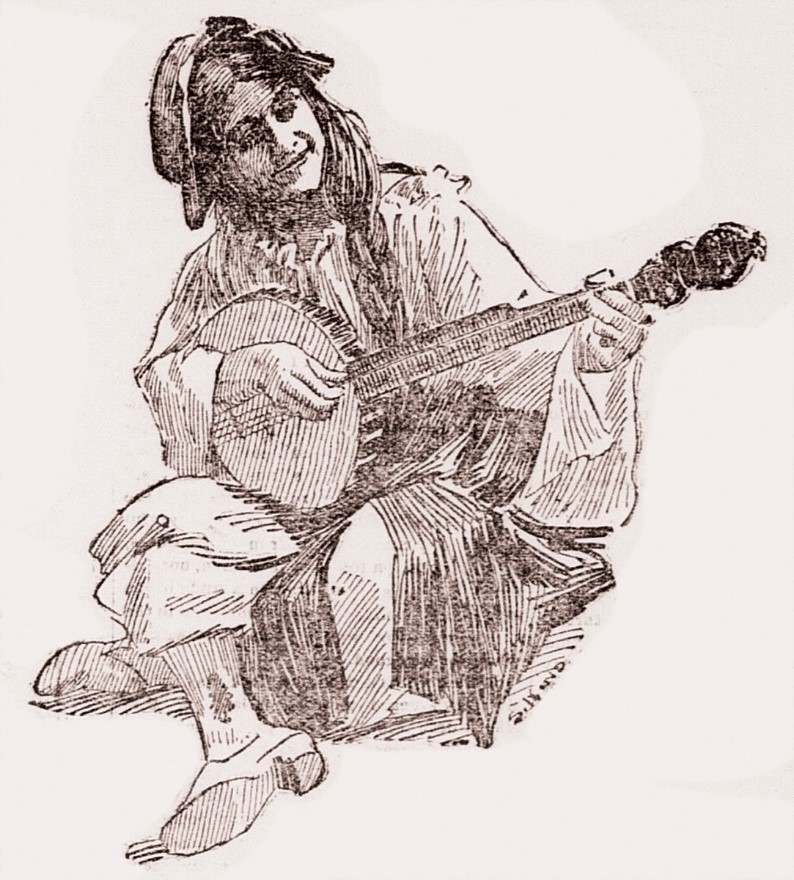 .
.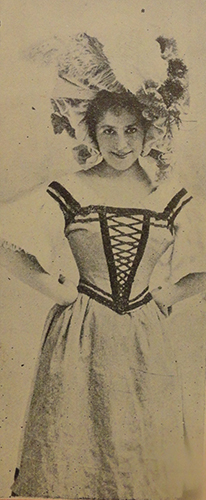
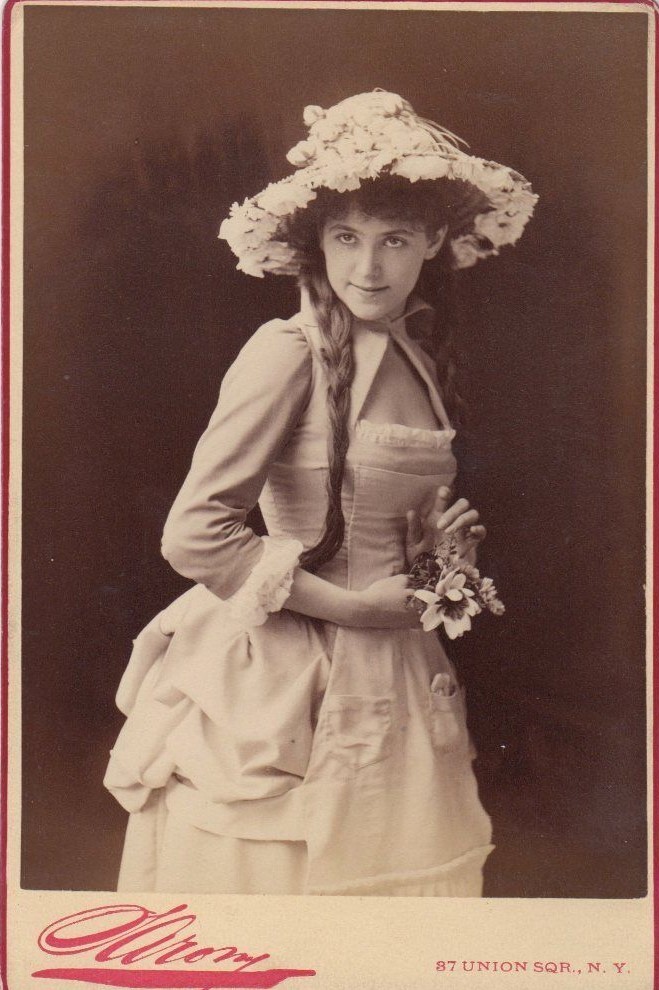
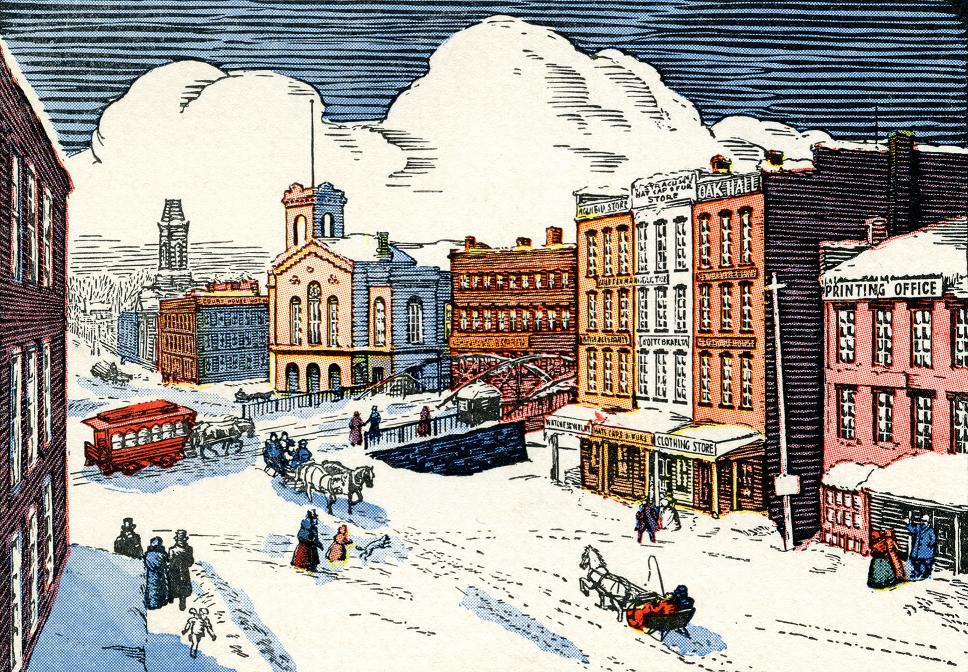
Syracuse NY mid 19th century
.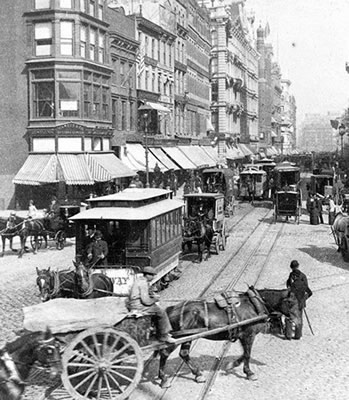
Union Square - Broadway, 1892
No Recordings:
It was announced in 1896 that Theresa would soon be recorded on wax cylinder recordings... but unfortunately, I believe she passed away before that happened. Newspaper and periodical research helped to learn about Theresa but building and playing Buckbee banjos and learning her music was extremely helpful to the process of discovering Theresa better.
Buckbee banjos:
John H.Buckbee (NYC) built drums during the Civil war. He started building banjos in 1867. He was the most prolific banjo builder from 1867 to 1897. It was said Henry C. Dobson and other builders at times bought Buckbee's and re-labeled them.
Buckbee banjos were very popular.
I'm now exactly replicating silver-plated and gold-plated 1880 Buckbee banjos.
These replicas sound, play & feel exactly my original 1880 Buckbee both discovered hibernating for 115 years, nearby, in a Gardiner, Maine attic.
The magical Buckbee tone was due to its rim design. They were made by steaming and bending a solid, 0.263 maple board to become an 11" diameter rim (single-ply). The maple rims are very tightly encased in a 0.025 brass sheath. Theresa used such a banjo to accompany her singing.
After 1900, banjo builders (Fairbanks, Gibson, etc.) increasingly began using laminated (plywood) rims. Steam bending was too tricky for mass production as we began the 20th century. These days banjos all have plywood rims even the most expensive ones. Endless metal internal tone rings were designed to improve the poor tone of the plywood rims... they gained back the lost volume but lost the magical ring of the bentwood Buckbee.
These replicas are wonderful to play. They sound just like my original 1880. You can hear the 1880 Buckbee .. original and replica on videos below. They are very responsive and they; tell you the best way to do this or that.
Project Background:
Could be close to how Theresa sang it: Click here
This project illuminates the evolutionary missing link between our very earliest folk, Broadway, Circus, Appalachian and Minstrel music to the wonderful music of Rogers and Hammerstein II ( R&H ) that would soon emerge from Theresa's influence ... her paradigm shift.
Thankfully there is still a trace of Theresa's artistry today.
.... it's Broadway, especially the R&H shows.
In case you're not familiar with the magic of Rogers and Hammerstein II
or would like a good review of their wonderful works, Accuradio is a wonderful free resource. (24/7) Click Accuradio, select Broadway, then select Rodgers & Hammerstein II. You may be amazed at the amount of very artful music & poetry they produced.
AccuRadio.com Click here
... it was all Shakespeare!
Hopefully this project will inspire a beautiful, cultural/musical Renaissance to blossom everywhere. This is important.. especially these days. "Culture"
and too many of us are now deficient in these eight essential cultural ingredients:
Beauty, Warmth, Poetry, Love, Tradition, Sweetness, Magic/Sparkle, and Romance.
I believe this project can help bring us to a healthy
balanced new Renaissance ... culture, and music.
We all need a culture we can actually love and agree on again.
To get there we all need to learn a bit.... and enjoy a paradigm shift to more perspective and understanding. If not we'll remain unglued and fragmented. I believe it's very important to heal the severe cultural polarization/fragmentation now well underway. Theresa's music and influence were healing, integrative. I believe the cultural effect of her artistry and music helped us recover from the Civil war.
This project may lead us to such a wonderful Renaissance. Culture does count ... it's very fundamental .. effects EVERYTHING. It's like good air and water.
From my research, it seems American culture reached a very beautiful hi-peak between 1880 and 1895. Rodgers and Hammerstein II's music of today may be the last remaining trace of that earlier very special time. Theresa Vaughn's time and her cultural influence is an ideal starting point for a new Renaissance to emerge from. She's a wonderful Muse for us. 1880-1895 is a good Renaissance restore point for a good cultural reset/reboot.